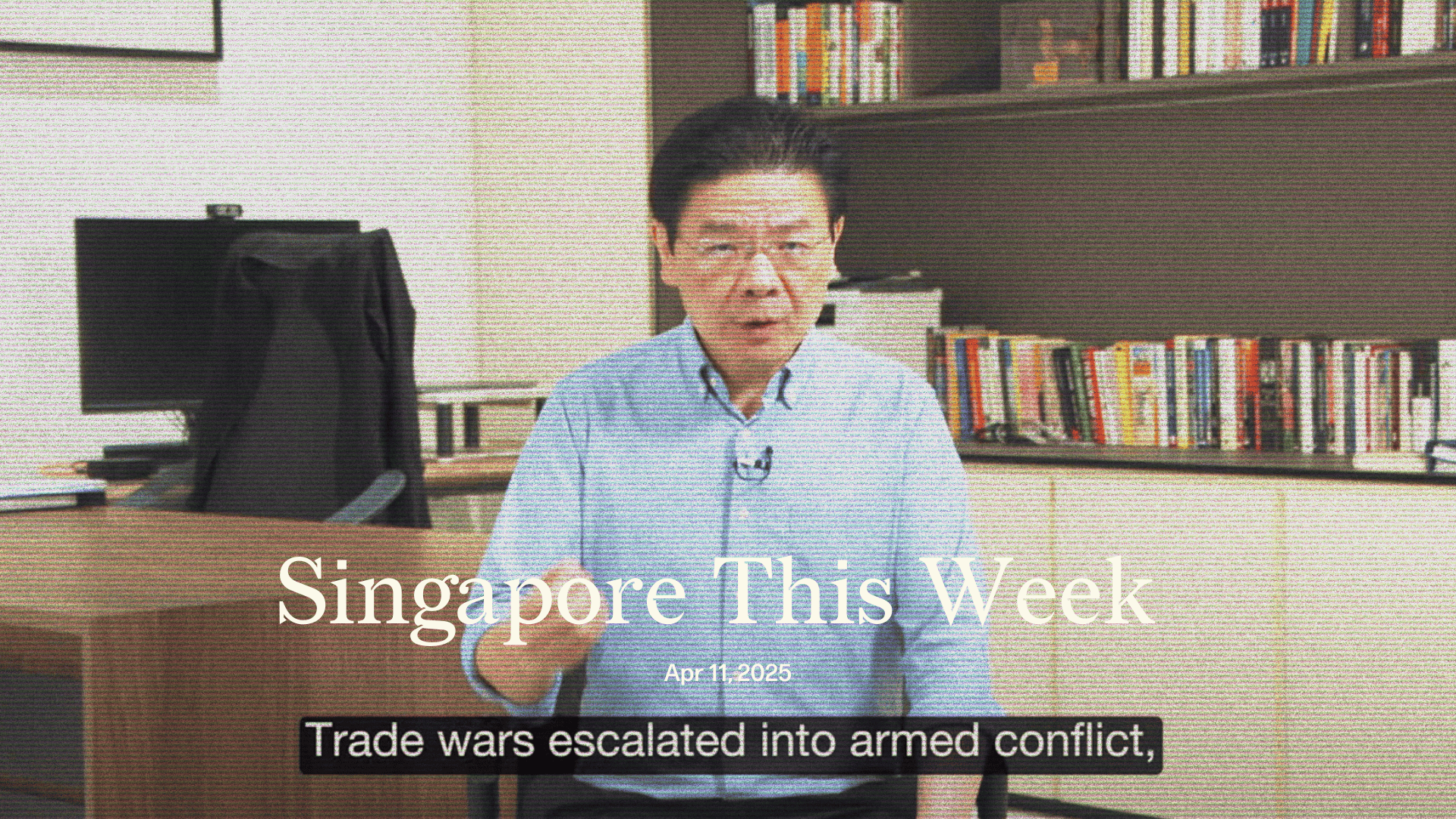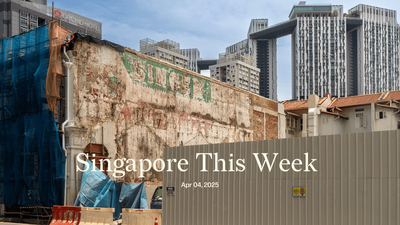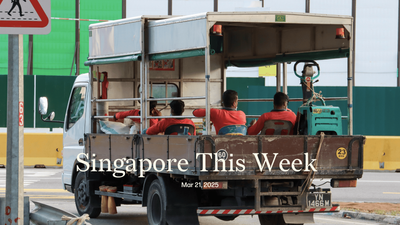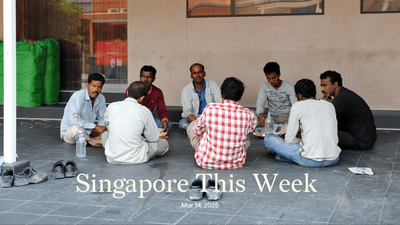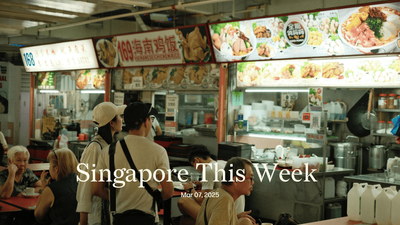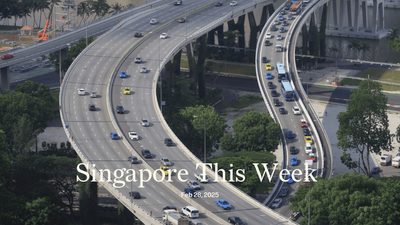Politics: Trump, tariffs and threats
The capricious actions of Donald Trump, US president, will continue to rock regional stability and incite market volatility. And the ruling People’s Action Party (PAP) will surely remind you of it. Just two days after Trump announced “reciprocal tariffs”, including a baseline 10 percent tax on imports from all countries, Lawrence Wong, prime minister, filmed a video about a “seismic change” in the global order. He called for “a resolute and united Singapore”, as he referenced 1930s trade wars, which “escalated into armed conflict and eventually the second world war.” Woah. That did escalate quickly. Last Saturday, his lieutenants echoed the warnings. Vivian Balakrishnan, foreign affairs minister, also spoke of a “profound setback” that heralded the 1940s. K Shanmugam, law and home affairs minister, spoke about “a shadow that is forming across the world”.
We can both appreciate the risks to Singapore, a highly trade-dependent economy, and the fact that the PAP, as it’s always done, will try and leverage them for political gain, so close to a general election (GE), which must be held by November, but could be in a matter of weeks. But the opposition is wisening up. Pritam Singh, Workers’ Party (WP) chief, agreed with Wong’s call “for a united population in the face of significant uncertainties”, but reframed unity in terms of diversity, including in Parliament. Tan Cheng Bock of the Progress Singapore Party (PSP) said that ministers were trying to “instil fear in the voter”. On Tuesday, Wong responded in Parliament with a far more measured and rigorous analysis of the likely repercussions for Singapore.
It’s unclear, moreover, if this is the bogeyman that will help the PAP electorally. If indeed Trump heralds the end of the post-war neoliberal global order, should Singaporeans place our trust in the PAP, the very party that has so enthusiastically embraced it, that has accelerated our trade dependence? Economist Donald Low wrote a sober analysis of the predicament, arguing that Singapore can build its resilience in a deglobalising world by raising its “unusually low” domestic consumption. This “would require the government to run smaller fiscal surpluses and to reduce the need for Singaporeans to set aside so much of their incomes for housing.” A more equal society—through more aggressive redistribution—would also help. Those with lower incomes typically have a higher marginal propensity to consume—meaning they’d spend relatively more of every additional dollar earned. All this is what the PSP and WP, in different ways, have been calling for. Related, if indeed Singaporean workers are going to be affected by these confusing, on-again-off-again tariffs, which political parties will they trust to assuage their everyday malaise?
Some further reading: Contrast the PAP’s fearmongering with criticism of Trump’s “Ruination Day” from The Economist, which mentioned the 1930s without lapsing into talk about war. “But it looks as if officials set the tariffs using a formula that takes America’s bilateral trade deficit as a share of goods imported from each country and halves it—which is almost as random as taxing you on the number of vowels in your name.”
In “The unchanging PAP playbook”, Jom argues that the PAP’s continued reliance on the politics of fear may ultimately be self-defeating.
Politics: Election round-up
Deferred land costs to reduce BTO flat prices, a return to seven percent GST (from nine), and an optional PSLE are some of the key manifesto promises made by the PSP. The manifesto also proposes far-reaching electoral reform, a wider social security net, and changes to the Newspaper and Printing Presses Act 1974 for a healthier media eco-system. “[I]t is unfair for the Government to say that the Opposition has not suggested alternative solutions,” wrote Leong Mun Wai, secretary-general and non-constituency member of Parliament (NCMP), in his preface to the 78-page document. Separately, Leong confirmed that the PSP will contest only in the Chua Chu Kang and West Coast-Jurong West GRCs (latter created from the freshly mangled Jurong GRC). In 2020, PSP fielded candidates in four GRCs and five SMCs but could mount a serious contest only in the West Coast GRC. “Our conclusion from the last election is that we need to focus a bit more,” Leong said. Nice euphemism, a sceptic might contend, for a failure to recruit.
The Singapore Democratic Party (SDP) is focusing on the five-member Sembawang GRC, where it unveiled a strong team that includes vice-chairman Bryan Lim, political scientist James Gomez, and treasurer Surayah Akbar. “We are not getting some CEOs parachuted in at the last minute, but we have people who have walked the ground in Sembawang,” said Paul Tambyah, chairman. This is part of the party’s “northern strategy”, with secretary-general Chee Soon Juan already having announced plans to contest the Sembawang West SMC. “[I]f we win Sembawang West and Sembawang, we will have a mega town council, for economies of scale,” said Lim. The SDP’s decision drew the ire of the National Solidarity Party (NSP), which has been contesting in Sembawang since 2015. A three-cornered fight is likely to benefit the incumbent People’s Action Party (PAP), which won more than double NSP’s vote share in 2020, under the leadership of Ong Ye Kung, health minister.
On the other hand, the East Coast GRC is likely to be a straight shootout between the PAP and the WP. The WP made serious inroads there in 2011, winning 45 percent of the vote, and gained further ground in 2020, with nearly 47 percent. This time, East Coast also includes the erstwhile Joo Chiat SMC which the WP lost by less than 400 votes in 2011. The PAP’s 2025 East Coast Plan includes frequent walkabouts by Edwin Tong, minister for culture, community and youth alongside the five-member team that includes Heng Swee Keat, deputy prime minister, and two new potential candidates. The WP team no longer features its star Nicole Seah. However, if it risked moving chief Pritam Singh there, as part of an expansionary strategy beyond its Aljunied stronghold, or fielded senior counsel and new entrant Harpreet Singh, that could take the WP over the elusive East Coast line.
Sign up for Jom’s weekly newsletter
Our newsletters combine weekly updates about Singapore with a “build-in-public” narrative, in which we tell readers about our start-up journey.
No spam. Unsubscribe anytime.
Politics: Palestine everywhere
The PAP has been repeatedly caught off-guard by the extent of pro-Palestinian activism here. The unfurling of a banner (“End SG-Israel Arms trade”) by three Singaporeans last year in Gardens by the Bay was perhaps the starkest example. The latest is the interminable tempest involving Calvin Cheng, honorary consul of Serbia to Singapore and notable PAP firebrand, who had suggested exiling close to 1,000 citizens who belonged to, or followed, a group called Monday of Palestine Solidarity. It has taken almost a month for the PAP’s Malay leaders, including Masagos Zulkifli, minister-in-charge of Muslim affairs, and Maliki Osman, minister in the prime minister's office, to come out strongly against him. Their path to censure may have been complicated by the fact that three of their colleagues, including Vivian Balakrishnan, foreign affairs minister, appeared to initially “Like” Cheng’s suggestion, offering support to it at the highest level. (Balakrishnan complained to Meta about unauthorised use, though he has yet to reveal the findings of Meta’s investigation.) This week, Cheng expressed remorse to two ustazs, and Wong condemned Cheng’s original remarks as “completely insensitive and unacceptable” while pointing out its racial connotations, referencing the concept of “pendatang” (foreigners or immigrants).
It’s clear the PAP has had trouble reading the Muslim ground. Perhaps sensing the need to express solidarity, Shanmugam this week said that Israel’s killing of 15 aid workers in Gaza deserves “universal condemnation”. It could be one of the most brazen war crimes ever documented. Those who doubt the savagery of the Israel Defense Forces, which Singapore has numerous ties with, would do well to watch the video from the Palestine Red Crescent Society.
Amidst the continued trauma and whiplash that many Singaporeans feel—peace here jolted by (digitally transmitted) carnage there—a book launch and community event this week offered a much-needed balm. Ethos Books launched Why Palestine?: Reflections from Singapore by Walid Jumblatt Abdullah, an associate professor at NTU. (Disclosure: Walid is an endorser of Jom.) Community vendor booths featured works by Big Fry Illustrations, Meja Conteng, and Singapore Youth for Peace. Amidst the potpourri of keffiyehs and watermelons, their tangible manifestations and their depictions billowing across the room, Walid expressed hope in our state’s and people’s awakening. There are progressives the world over who shun this issue, he said, the so-called Progressives Except for Palestine (or PEPs). He then paraphrased the last line of his first chapter: “Maybe, just maybe, soon enough, ‘except for Palestine’, will be replaced by ‘because of Palestine’.”
Note: Mercy Relief is raising funds for refugee camps. Donate here.
Some further reading: In “Genocide in Gaza? Our moral responsibility”, Jom interrogates Singapore’s historical ties to Israel, and our ongoing complicity with Israel’s war on Gaza.
Society: Follow me, but don’t copy me
Usually in their early-20s to late-40s, “finfluencers” such as SG Budget Babe, Jiax The Piggy Banker, The Weeblings, and The Woke Salaryman have gained increasing prominence online. They use social media and blogging platforms to share insights, strategies and tips on what to do with one’s money. But the number of complaints against financial influencers this year rose to eight, compared to an annual average of five in the past five years. The majority of these were attributable to two finfluencers in Singapore who shared “reasons for liquidating their investments from an investment platform”, said Alvin Tan, minister of state for trade and industry in Parliament.
That gets to the crux of the issue. Those who provide financial advice must be licensed and regulated under the Financial Advisers Act. But who defines “advice”? The Monetary Authority of Singapore sets out a two-stage test to determine the answer. But there is a prevailing belief that simply disavowing it as “advice” is sufficient cover. “I’m just a guy holding a fork [with a recording device attached to it] sharing what I’m going to do with my own money and this is not financial advice,” prefaced Seth Wee in a video on his YouTube channel, Sethisfy Personal Finance, before describing in generous detail how he broadly splits his funds across various investment-growing “pots”. The video’s caption further warns that the information and articles on his channel do not “constitute financial, investment or trading advice.” This is the same Seth Wee who early last month presented the reasons why he was taking his money out of financial services firm Chocolate Finance, while disclaiming again that it was not financial advice. The following day, the company in question suspended instant withdrawals, citing high demand. Coincidence or a sign of Wee’s “finfluence” over more than 60,000 followers across his various social media platforms? One commenter suggested that Wee make an apology video for the stress he had caused thousands of Singaporeans. Another chided him for inciting fear and panic.
Finfluencers like Wee, whose online following isn’t insignificant, straddle a fine legal line (he recently quit his job as a financial representative) between benevolent financial sage and reckless money whisperer. For the financially illiterate or those eager to turn their hundreds into thousands into millions, regulation and prudence are essential layers of protection against greed, ignorance and misinformation. A new study shows that younger Singapore residents are leading the charge in owning and using cryptocurrencies for daily transactions. When it comes to financial investments, we’re bolder, more adventurous and ever willing to take matters into our own hands. But that also makes us more susceptible to hacks, fraudsters and scam artists.
History weekly by Faris Joraimi
How do you right a wrong that is so old, it’s remembered only by you and a few others directly affected? Do you wait for the state, and trust its process, or gather your friends, build your own process and momentum? Earlier this week, the descendants of 24 unarmed villagers murdered by British soldiers during the Malayan Emergency may get some small reprieve after the UK government expressed its “deep regret”. Between the night of December 11th 1948 and the next morning, a British platoon shot to death all 24 men living in a small village near Batang Kali, Selangor, after separating them from the women and children. Local newspapers lied, calling the slain men “bandits”—their code-word for communists—trying to escape, while the War Office in London called it “a very successful action”. In the decades since, silence reigned. Popular narratives continued to paint the victims as communist sympathisers. There was little official acknowledgment of the tragedy at Batang Kali, with far more attention dedicated to remembering the 1950 Bukit Kepong Incident when 14 Malay policemen were killed by Malayan Communist Party forces. (A 1981 film dramatised that event, as did a novel taught in Malaysian secondary schools.)
From the 1990s, however, Malaysian Chinese political parties began raising the issue in Parliament, and the Malaysian Chinese Association made a petition to Queen Elizabeth II. New evidence emerged based on testimonies by the British soldiers. In 2008, the survivors’ family members formed an Action Committee seeking an official apology, financial compensation for the affected families, and material contributions towards the development of Ulu Yam, the district where the village was located. In 2012, 2014, and 2015, British courts dismissed calls for an inquiry into the incident, arguing that it was a cold case that happened too long ago, but declared that “innocent men” were indeed “mercilessly murdered”. The family members brought their grievance before the European Court of Human Rights in Strasbourg, another dead-end. Lobbying by the Action Committee continued, led by lawyer Quek Ngee Meng, culminating in another petition to the UK last December that coincided with the massacre’s 75th anniversary. In response, Catherine West, a junior minister in the foreign office, issued a formal letter on behalf of His Majesty’s government. She acknowledged the survivors’ suffering, compounded by “unhelpful, incorrect” narratives. But still no apology. A victory is a victory, nonetheless, in any arduous quest for closure.
Arts: Mother tongue-tied
A young man is reading from an open textbook. His fellow Chinese classmates are clustered around him; one’s laughing nervously, one’s hunched over, another looks like he’s hoping he won’t be called on next. Their Malay-language teacher, wearing a demeanour of practised patience, has chalked out some questions across the blackboard: “siapa nama kamu?” (“what is your name?”), and “di mana awak tinggal?” (“where do you live?”). This isn’t a scene from a third-language class, but from “National Language Class”, a 1959 painting by Chua Mia Tee that now hangs in the National Gallery Singapore.
Younger Singaporeans are going through a “same same but different” experience in their language classes more than six decades later: an anxious apprehensiveness about a tongue they’re supposed to have inherited, to be fluent in, but aren’t. Except our lingua franca is no longer Bahasa Melayu, part of an invigorating postcolonial Malayan imagination, but English, part of a practical strategy for inserting ourselves into the post-war, US-led, global capitalist order. And acquainting ourselves with our “mother tongues” means the mandatory acquisition of Malay, Chinese, or Tamil in school, in accordance with our reductive, check-box categorisation of ethnicities here. Booksellers specialising in language-specific titles for students have mushroomed both online and off, catering to concerned parents and cavalier children. “Do your children roll their eyes when you mention Chinese books? I have two such kids,” Tan Ee Ling, founder of Chinese online bookstore Shiawase Books, told The Straits Times. “Whenever kids and adults tell me they don’t read in their mother tongue language, I let them know that it’s okay. They just haven’t found a story that speaks to them.” Tan’s in the company of Maha Yu Yi at Bras Basah Complex, which has tried to avoid the moral didacticism of earlier generations of Chinese texts; Tamilwithlove, which promises board games and other interactive ways of learning Tamil; and Mini Monsters, which offers animated versions of print books on their site, and is trying to promote home-grown educational materials in Malay, rather than “the over-dependency on Malay books and resources from across the Causeway, which are not always relevant to what the children in Singapore need,” according to director Lydia Cheriyan.
Enforced bilingualism isn’t a bad thing: it’s ultimately a corrective to what researchers call the prospective cognitive hegemony that comes with the widespread use of English, where a single language’s grammatical and conceptual idiosyncrasies might corrode cultural diversity to produce “an arbitrary construction of reality”. But for a once-polyglot nation, bilingualism is the shadow of what we used to be—and could have been. In playwright Thomas Lim’s perpetually sold-out play “Grandmother Tongue”, an Anglophone young man—not so far in age from the one in Chua’s painting—picks up a dialect he’s lost to reconnect with his Teochew grandmother. Perhaps our lips will loosen a little when they’re in the service of relationships, rather than a slave to test scores.
Tech: Grab crawls deeper into daily life
There’s something for everyone in the latest slew of features unveiled at the inaugural GrabX showcase. The most notable? “Grab for Family | Teens”, to be rolled out in May 2025. It lets teenagers aged 13-17 book rides under parental oversight—a smart play to hook the next generation of users. It also has PIN verification and real-time trip tracking, important for consumers in countries where safety is a concern.
For solo diners tired of inflated fees, “GrabFood for One” eliminates minimum orders and slashes delivery costs. Even smarter is the “Shared Saver” pilot (launching in April) that lets users piggyback on nearby orders to split fees—a clever crowdsourcing twist that could reshape last-mile logistics. Frequent flyers get upgrades too: “Advance Booking (Airport Pickup)” now syncs with flight delays, while the “Travel Pass” bundles ride and dining discounts across South-east Asia—a clear bid for the tourist dollar. And with “Dine Out Discovery” (powered by GrabMaps), the app nudges users toward partner restaurants, further embedding itself in the discovery-to-payment loop.
The takeaway? Grab is gradually entrenching itself in our lives, one hyper-specific feature at a time. Every update tightens its ecosystem, making it harder for users and competitors to break free.
Tech: Singapore’s cyborg cockroaches to the rescue in Myanmar
In a world-first for humanitarian aid, Singapore has deployed 10 cyborg cockroaches to assist search-and-rescue efforts in Myanmar following the devastating earthquake. Developed by HTX (Home Team Science and Technology Agency) in collaboration with NTU and Klass Engineering, these biohybrid robots, remote-controlled cockroaches fitted with infrared cameras and sensors, were fast-tracked for real-world use despite still being in the R&D phase.
Just six cm long, the cockroaches excel at navigating tight rubble spaces, relaying data via machine-learning algorithms to detect signs of life. While they haven’t yet found survivors, they’ve provided critical reconnaissance in collapsed structures, including a hospital spanning two football fields. The Operation Lionheart team of the Singapore Civil Defence Force includes engineers and search dogs, and has faced extreme conditions—38 degrees celsius heat, power outages, and emotional pleas from locals.
Deployment of these robo-roaches, which survive on carrots and water, marks a significant leap for robotics in disaster response. Lessons from Myanmar will shape future iterations, with mass deployment expected by 2026. The operation is not without its critics though. Some Burmese have expressed irritation with Singapore’s apparent leveraging of a tragedy to showboat and test new technologies—when many just need filtration devices for clean water. Perhaps the larger lesson is that healthy, trusting, sustainable relationships between the peoples of countries is dependent on long-term, deep transparent engagement, and is certainly not helped by Singapore’s role as a broker of arms and finance for the junta.
If you enjoy Jom’s work, do get a paid subscription today to support independent journalism in Singapore.

